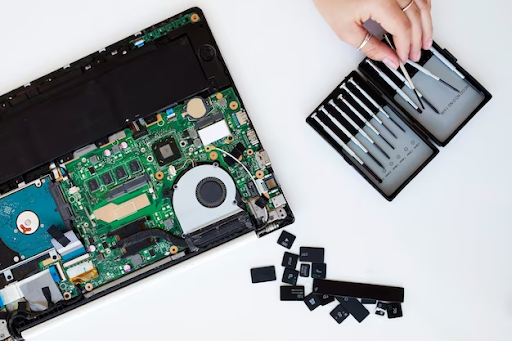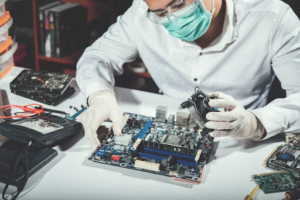
Walk into any electronics store these days, and you’ll see gleaming new gadgets with the latest features and specs. These devices seem appealing, but there’s an environmental cost to constantly producing new electronics that often goes unseen. From scarce raw materials to GHG emissions from manufacturing, our desire for the newest tech takes a heavy toll on the planet in the form of an increased carbon footprint. Between 2014 and 2020, embodied GHG emissions from e-waste generated from ICT devices increased by 53 percent with 580 million metric tons of CO2 emitted in 2020.
But what if there was another way to get our hands on smartphones, laptops, tablets, and other gadgets without sacrificing sustainability? That alternative exists in the form of refurbished electronics. These pre-owned devices have been tested, repaired, and restored to full working order. When we buy refurbished instead of brand new, we extend the usable lifespan of already manufactured gadgets. This practice keeps e-waste out of landfills and slows the demand for newly mined resources for building tech products.
The Refurbished Electronics Market Is Growing
Over the past decade, the refurbished electronics, especially the refurbished laptops market, has gone from a little-known niche to a booming, multi-billion dollar industry. Tech giants like Apple and Samsung now sell certified refurbished products alongside their new wares. Independent refurbishing companies have also gained prominence, using advanced diagnostics and quality assurance testing to bring pre-owned devices up to “like-new” standards. Buying refurbished laptops and desktops rather than new ones has a competitive advantage as they are available at a fraction of the original price.
As refurbished electronics become more available, and consumers become more aware of this category, sales continue to surge yearly. Market researchers predict the global market for refurbished smartphones alone could grow to $65 billion by 2024. With increasing options for refurbishment, there’s no need to automatically default to buying new.
Environmental Benefits of Choosing Refurbished
Opting for a refurb over a new device is one of consumers’ most eco-friendly purchasing decisions. E-waste is one of the fastest-growing waste streams on the planet, with 50 million metric tons generated globally each year. Repurposing electronics rather than constantly manufacturing new ones can dramatically slow this waste crisis.
Specifically, refurbishing extends a gadget’s usable life by 12-24 months on average. Research shows that refurbished devices can provide 86% of the lifecycle utility of brand-new electronics. In other words, the minor cosmetic imperfections that define a refurb make little practical difference in daily performance and longevity. By giving good-as-new devices another go-round, consumers diminish waste and avoid some of the worst impacts of tech production. Making use of refurbished electronics is a step in the direction of environmental sustainability.
Creating a Circular Economy for Electronics
In our current linear “take, make, dispose” economy, less than 20% of e-waste is formally recycled or refurbished. When we mine rare Earth metals, manufacture components, assemble gadgets, and almost immediately toss them out, it’s a disastrous picture for environmental sustainability.
But the right policies and consumer behavior shifts could create a closed-loop, circular economy for electronics. This model assesses end-of-life tech for refurbishment or device-to-device component reuse instead of landfilling.
Strong secondary electronics markets also boost circularity. Certified refurbishers give old smartphones, laptops, and other devices vigorous second lives before the gear eventually gets recycled responsibly. Governments can encourage circularity by incentivizing eco-conscious electronics purchasing for their workforces. 
Accessible Sustainability: Refurbs Bridge the Digital Divide
For lower-income groups, access to affordable, functional tech enables social mobility and quality of life. However, with new electronics prices rising, many get left behind by the digital divide. Refurbished electronics close this gap, making mobile devices, PCs, laptops, accessories, and smart home gadgets accessible to wider income brackets.
Non-profit outfits further this mission by partnering with schools, libraries, and community programs. Through these initiatives, they deliver refurbished devices and internet access tech to disadvantaged groups. Such pay-it-forward arrangements demonstrate how the secondary electronics market has sustainability benefits across dimensions – helping the planet and people.
What Does the Future Hold?
 As refurbished purchasing gains steam, manufacturers may build sustainability into gadgets from the initial design stage. Components could get engineered for easy disassembly and refurbishment down the line. Devices may even ship with visible metrics estimating their full lifecycle impacts.
As refurbished purchasing gains steam, manufacturers may build sustainability into gadgets from the initial design stage. Components could get engineered for easy disassembly and refurbishment down the line. Devices may even ship with visible metrics estimating their full lifecycle impacts.
Tech giants are catching on to the durability trend, too. Apple already provides discounted battery replacements to prolong iPhone lifespans. And thanks to right-to-repair pressure, more OEMs may soon make their devices user-serviceable.
Alongside these design-phase shifts, advanced recycling technology can help complete the sustainability loop. Innovators have already found ways to recover rare Earth metals from electronics headed for landfills efficiently. As these recycling robots and AI sorters improve, they’ll help electronics producers tap back into already extracted resources.
Conclusion
The future of refurbished electronics looks promising as more and more people are incorporating sustainable tech habits. The revolution of sustainable tech all starts with buying refurbished electronics over new ones. Choosing refurbished laptops and desktops over new ones will limit the amount of e-waste entering landfill sites. The concept of circular economy and accessible sustainability will gain prominence in days to come as we head for a more conscious choice and time.
Author Bio :
Written by Olivia Benson from Pure IT Refurbished. They are one of the UK’s leading suppliers of refurbished IT equipment.






